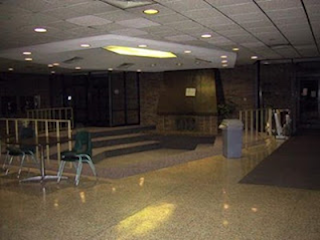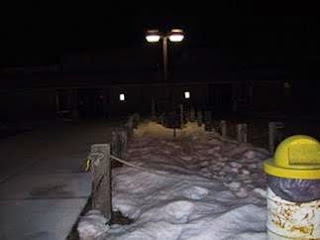I have not written
the past little while because I was in and out of the hospital with kidney
failure. We now have it fully under control through dialysis and things are
back to a new normal. So I am going to be writing the blog again and I hope you
find it worthwhile. For this blog I am rewriting one of the most requested ones
I ever wrote about lighting. Hardly a week goes by without someone asking for a
copy of this piece so I am posting it again here.I should be back to new posts
next week so stay tunes and let others know of the blog. Thanks.
September 11 is coming around again and this
time it is a big commemoration anniversary. The event is going to resonate
again and make some student feel uncomfortable and somewhat insecure or even unsafe on campus. This
is going to be especially so in the evenings when college #2 starts for adults.
And we will add to this by making sure that we save money by losing students.
Or at least by decreasing lighting in an
attempt to save money which in turn will make some students feel unsafe and not
like coming back. People may not realize it, but lighting is a definite customer service objective correlative aspect that directly can affect retention.
Over the years I have studied customer
service issues in colleges, and after an event that could
make people nervous it is not surprise that students shared that anxiety. This
is especially so for evening students. Evening students are primarily
adults who have experienced enough of life to know that hurt or even death can
be an entirely random event. They get worried particularly in darker places;
where the evil hides. The same levels of concern exist for resident students as
for commuter students.
Over the years, I have found a trend among resident students to define distance from home as a
comfort factor. The closer the school is to their home, the safer they assume it is. In fact, resident students may even
get a bit more careless about safety than commuting students but there is no
way of truly knowing that since colleges still are bad at really reporting
incidents and many commuter students report incidents to local police; nor
campus security.
Leaving Students in the Dark
Commuter students consider a trip of more than
30 minutes in length an annoyance and a factor in
choosing to attend one college over another. It is not distance
but time in commuting that is factor to look at for your commuting
students. And like resident students, the longer it takes to get to campus, the
further from home it is even if it just a few miles like for someone who
commutes to class on Long Island’s parking lot known as the Long Island
Expressway.
But student attitudes about distance to a
college are not even close to how they feel about the walk from the car to the
classroom. If they arrive at a parking lot at night that is distant from
their classroom and it is dark, many students will turn
around and leave even if the class is not that far away but the way is dark.
This is especially so if the walk is by a person by him or herself. By the way,
this is true for resident students. Walking in the dark is not made to feel any
less anxious for them Students
feel vulnerable and do not want to have to walk through a dark campus.
Classes are starting up as the 9/11 anniversary builds and comes
to a conclusion. It will bring back feels nervousness, especially is the campus is not well-lit. If this is
the feeling that students have during their
first week as night students, it is
likely that they will withdraw.
Over the past decade and
even more in the past two years, colleges and universities have become very conscious of the cost of
electricity. To cut costs, college
officials reduced the number and wattage of bulbs throughout the campus,
especially in lobbies and hails. They also installed less expensive, but also less light-intense, neon bulbs and have become
lackadaisical about replacing burned out bulbs. But schools need to realize
that what might
pass as a romantic or atmospheric darkness in a restaurant may not produce the same feelings on
campus. In fact I would suggest that darker halls, parking lots and campus
pathways will be viewed as precarious and foreboding.
Let them see the light
Over the years while checking on a school’s campus as customer
service factor, I have seen students approach a lobby and hesitate to enter
before scanning it. They also halt before entering a hallway to get to classes when the hall is not well lit. In an audit, I saw six students individually approach a weakly lit rear entrance of a classroom
building, look in, see no one else
inside and wait for another person to come along before they would enter the
hall. Four of six waited until
another student came to the door and then
entered together, and two left.
At one institution, I
observed five cars enter a poorly lit parking area at night, circle it three times looking for a spot near one of the working lights and
leave when they could not find a well-lit
spot. Those that circled and stopped in a darker area, left their cars hesitantly and walked across the
lot looking anxiously for any signs of
danger.
I see the same reaction in
students walking across campuses.
Students will travel the brightest pathway and not go onto ones where lights are too dim or out. At one institution, a path was well lit until
students entered an area where a
dead bulb was not replaced. They walked up
to that spot then left the walk to cross over an open , better lit grassy area to get to another walk 200 yards away.
The solution is easy.
Replace all light bulbs that are out.
Increase wattage wherever you can. Keep lobbies, entry areas
and all walkways well lit. If possible, increase the number of lights in parking areas. And if possible, offer escort services to all your night students.
The author Dr. Neal
Raisman is the leading presenter, researcher and consultant on customer service
for retention in colleges, universities, community and career colleges in the
US, Canada and Europe. He and his associates have provided retention solutions
for over 300 schools and businesses that want to work with higher education.
Dr. Raisman is the author of over 400 articles and four books including his
latest bestseller The Power of Retention; More Customer Service for Higher
Education available from The Administrators' Bookshelf in hard
copy and digital editions.
GET A COPY OF FROM ADMISSIONS TO GRADUATION BY DR. NEAL RAISMAN BY
CLICKING HERE.
If you would like to discuss a retention issue or see if he has
a time available to come to your school or business for a workshop,
presentation or other retention solution such as a full customer servicing
audit,
CALL 413.219.6939 OR CLICK NOW FOR A FREE 30 MINUTE CONSULTATION
ON ANY RETENTION OR CUSTOMER SERVICE ISSUE. Start improving your enrollment and
revenue NOW.
413.219.6939 or email info@GreatServiceMatters.com













